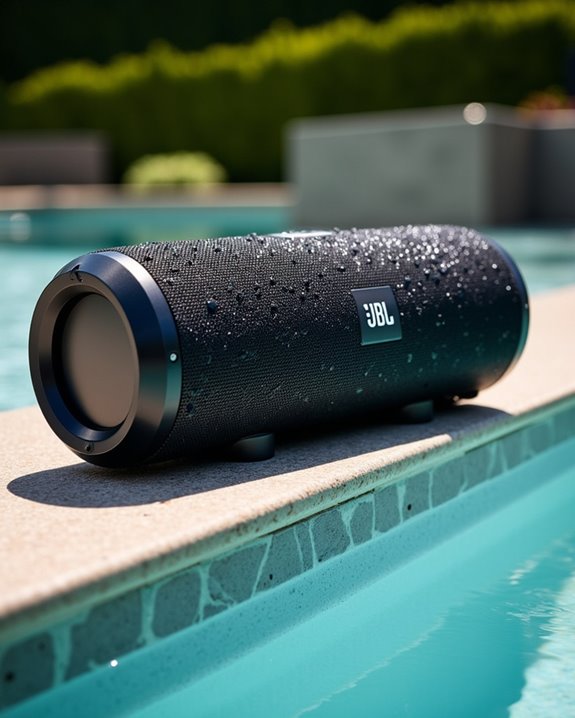To confirm if JBL speakers are waterproof, check the IP rating on the product packaging, manual, or official JBL website under “Tech Specs.” Look for ratings like IP67 (dustproof and waterproof up to 1 meter for 30 minutes) or IPX7 (water-resistant without dust protection). Popular waterproof models include Flip 6, Charge 5, and Pulse 4. Verify port covers are intact before water exposure. The following sections explain testing methods and maintenance practices to preserve your speaker’s water protection.
Key Takeaways
- Check the product packaging for the IP rating code (IP67, IPX7) near safety information or certification symbols.
- Visit JBL’s official website and search your model under “Tech Specs” to verify the waterproof rating.
- Review the product manual in the “Support” section for specific waterproof capabilities and limitations.
- Look for physical indicators like sealed port covers and rubber gaskets that suggest waterproof construction.
- Perform a controlled test by lightly sprinkling water on non-essential areas after confirming your model’s IP rating.
Understanding IP Ratings for JBL Speakers
When shopping for JBL speakers intended for outdoor or wet environments, understanding IP ratings becomes essential for making an appropriate selection. The IP Certification (Ingress Protection) provides a standardized measurement of environmental resistance using a two-digit code system established by the International Electrotechnical Commission. JBL’s Rating History shows progressive improvements in their weatherproofing technology across product generations.
The first digit (0-6) indicates protection against solid particles, with 6 representing complete dust-tightness. The second digit (0-9) measures liquid resistance, where ratings like IPX7 indicate submersion capability up to 1 meter for 30 minutes. Members of the JBL community should note that some models achieve IP55/56 ratings by default, while others require optional accessory upgrades such as PC2/3 glands or specialized grilles to enhance weather resistance. Additionally, waterproofing standards such as IPX7 are tested under controlled conditions that may not fully replicate real-world exposure, so always consider the environment in which the speaker will be used.
Popular Waterproof JBL Speaker Models and Their Ratings
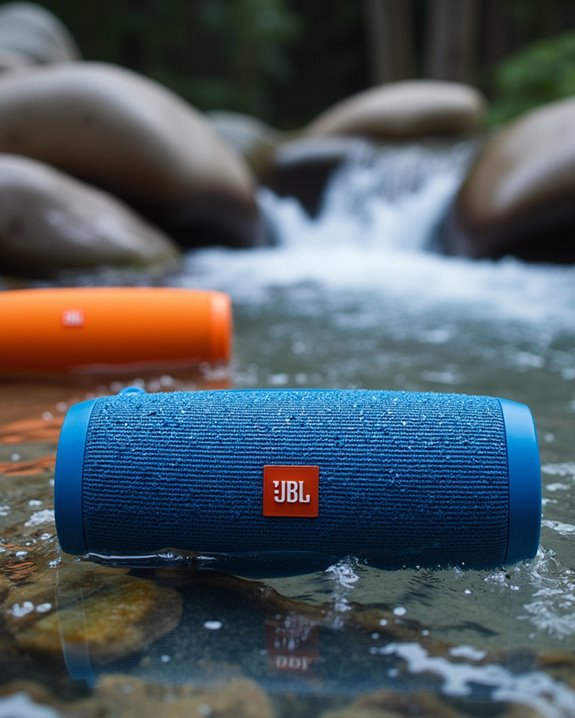
JBL’s lineup of waterproof speakers represents a diverse range of options for consumers seeking audio solutions that withstand environmental challenges. The Flip 6 and Charge 5 lead Rating Trends with their impressive IP67 protection, ensuring complete dust resistance and water submersion capability up to one meter for 30 minutes. Model Innovations are particularly evident in the JBL Pulse 4, which combines waterproofing with a mesmerizing 360-degree light show, creating a multisensory experience. The Xtreme 4 and Boombox 3 offer more substantial sound profiles while maintaining rugged durability for outdoor enthusiasts. Consumer ratings consistently award these models 4+ stars, with particular praise for the PartyBoost feature that allows multiple speaker connectivity and the powerbank capability found in the Charge series, extending functionality beyond audio performance. Additionally, many of these waterproof JBL speakers feature advanced sound technologies, such as IPX4 or higher waterproof ratings, ensuring resilience against splashes and sprays during outdoor use.
How to Locate Your Speaker’s IP Rating

Locating the IP rating of a JBL speaker provides essential information about its water resistance capabilities. Consumers should first examine the product packaging, which typically displays the IP rating prominently on labels or within specification sections. For more detailed verification, JBL’s official website offers detailed technical specifications, including complete waterproof ratings and environmental protection information for each speaker model.
Subheading Discussion Points
The accurate identification of your JBL speaker’s IP rating serves as the foundation for understanding its water-resistance capabilities. Consumers can locate this critical information through several reliable channels, including the product’s original packaging, technical specifications sheet, or the official JBL website. The manufacturer’s documentation typically lists the IP rating alongside other key specifications such as battery life and sound quality parameters.
For existing JBL speaker owners who no longer have the original packaging, the product manual offers detailed details about water resistance limitations. Alternatively, the model number, typically found on the speaker’s underside, can be used to search the JBL support database for precise IP specifications. Understanding this rating is essential for determining appropriate usage environments and preventing water damage that could compromise both sound quality and battery performance.
Check Product Packaging
Product packaging serves as the most immediate and reliable source for determining a JBL speaker’s water resistance capabilities. When examining a JBL speaker box, consumers should locate the IP rating, typically printed near compliance certifications or safety information. The IP code appears as “IP” followed by two digits (e.g., IP67) or with an X placeholder (e.g., IPX7), indicating specific protection levels against dust and water ingress.
JBL’s portable Bluetooth speakers often feature IPX7 or IP67 ratings prominently displayed alongside waterproof claims. Barcode scanning applications can help verify authenticity and access detailed specifications when packaging information seems limited. Seal verification is equally important, as intact factory seals indicate the waterproofing hasn’t been compromised. Consumers should retain packaging documentation until IP ratings are confirmed, especially for outdoor installations where environmental protection is critical.
Official Website Lookup
JBL’s official website serves as the definitive resource for verifying a speaker’s waterproof capabilities through its detailed technical specifications. With excellent website security and reliable loading speed, users can confidently access accurate product information.
To locate a speaker’s IP rating, navigate to jbl.com and select the “Bluetooth Speakers” category or utilize the search bar to find the specific model. Once on the product page, scroll down to the “Features” or “Tech Specs” section located below the main product images. Look for prominently displayed information such as “IP67 waterproof and dustproof” in the headers or bullet points.
For thorough verification, users can download the product’s manual from the “Support” section and search for “IP” to confirm the exact rating and understand the specific environmental protections their JBL speaker offers.
Waterproof vs. Water-Resistant: Important Distinctions
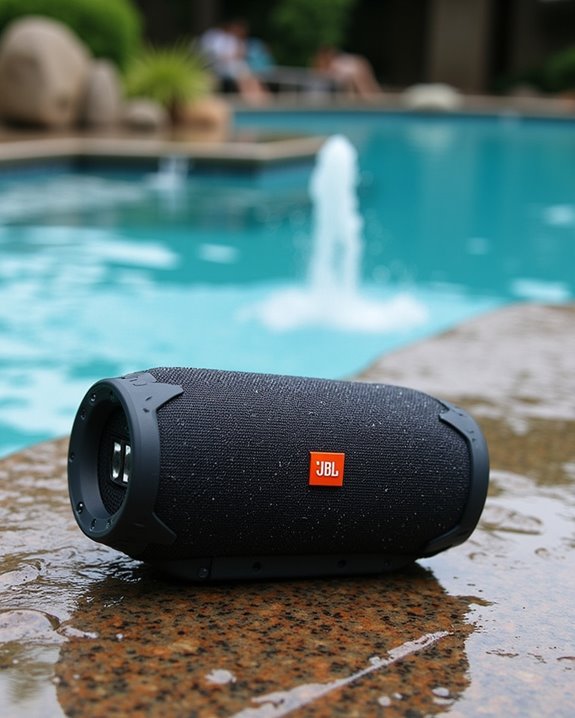
Understanding the critical difference between waterproof and water-resistant speakers can save consumers from potential disappointment and equipment damage. Term Usage in the audio industry follows specific technical standards, with manufacturers applying these designations based on established testing protocols. The conceptual differences between these classifications are significant: waterproof JBL speakers (typically rated IP67 or higher) can withstand complete submersion for limited periods, making them suitable for pool parties or beach outings. Water-resistant models, however, merely withstand splashes or light rain but fail when submerged. This distinction becomes essential when selecting speakers for specific environments. JBL’s waterproof models incorporate advanced sealing technology and specialized materials to prevent water ingress, while water-resistant versions offer more limited protection. Consumers should verify the exact IP rating rather than relying on marketing terminology alone. Checking IP ratings can help you make informed choices based on the intended usage scenarios.
Testing Your Speaker’s Water Protection (Safely)
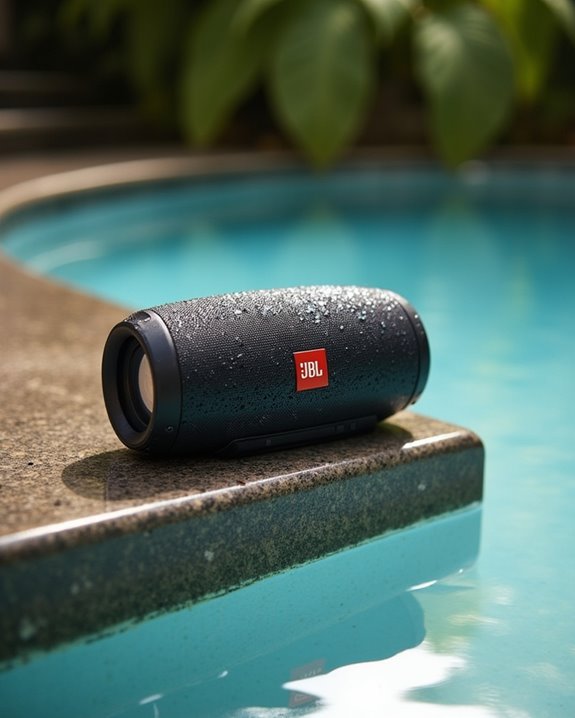
Verifying a JBL speaker’s waterproof capabilities requires methodical testing that respects the limitations of its IP certification. Proper validation involves controlled freshwater submersion at depths not exceeding 3.3 feet for a maximum of 30 minutes, while carefully monitoring for any performance anomalies. Post-test procedures, including thorough drying of ports and speaker components, are essential for maintaining the device’s integrity and preventing potential long-term damage from moisture exposure.
DIY WATERPROOF VERIFICATION
Testing the waterproof claims of your JBL speaker at home requires methodical, controlled approaches that minimize risk while verifying performance. Enthusiasts seeking budget verification methods can conduct simple tests that align with the speaker’s IP rating without endangering the device.
Begin with a splash test by sprinkling water on non-essential areas, observing if droplets penetrate the speaker’s sealed components. For IPX7-rated models, progress to a shallow submersion test in fresh water for 10-15 seconds (not the full 30 minutes). Creative methods include using a damp cloth on exterior surfaces to check for moisture intrusion or placing the powered-off speaker in a dry container with moisture-detection cards. These techniques provide preliminary confirmation while respecting the limitations specified in the IP rating without subjecting the speaker to unnecessary risk.
DAMAGE-FREE TESTING METHODS
When approaching waterproof verification, owners of JBL speakers can employ several risk-free techniques that confirm water resistance without jeopardizing the device’s functionality. The most reliable method involves verifying the manufacturer’s stated IPX7 or IP67 rating in the product documentation rather than conducting submersion tests independently.
Advanced technology offers non-invasive options for concerned users. Thermal imaging can detect potential seal weaknesses by identifying temperature differences that might indicate compromised areas. Similarly, ultrasonic detection equipment, available at specialized service centers, can identify microscopic gaps in the speaker’s protective barriers without water exposure.
Before any water contact, users should thoroughly inspect port covers and seals for damage. After minimal water exposure tests, immediate drying with a microfiber cloth helps preserve the speaker’s waterproof integrity and maintain ideal performance across its operational lifespan.
Maintaining Your Waterproof JBL Speaker
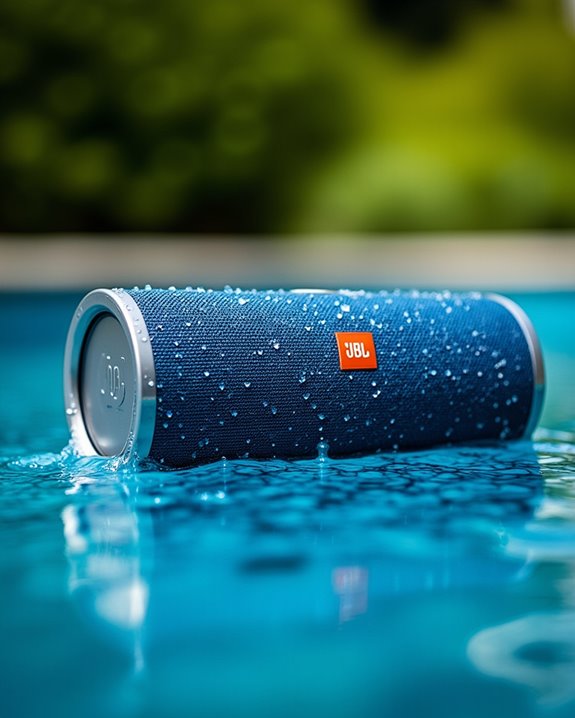
Proper maintenance of waterproof JBL speakers guarantees best performance and longevity, particularly after exposure to various environmental conditions. Owners should implement consistent Cleaning Methods by rinsing speakers with fresh water after contact with pool chemicals or saltwater, which prevents deterioration of IP-rated seals. A soft, damp cloth should be used for exterior cleaning, avoiding harsh chemicals that may compromise waterproof integrity.
Effective Storage Techniques include placing speakers in dry, moderate-temperature environments when not in use. Protective covers offer additional safeguards against dust accumulation and moisture intrusion. Regular inspection of waterproof seals, ports, and connection points is essential for early detection of potential water damage. By following manufacturer guidelines for maintenance, users can extend their JBL speaker’s operational lifespan while maintaining peak audio performance in diverse environmental conditions.
Common Misconceptions About Waterproof Ratings
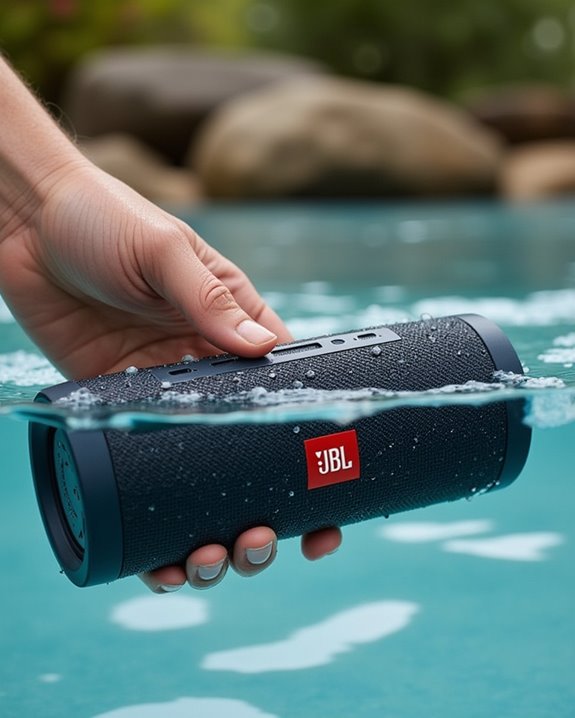
Many consumers misinterpret waterproof ratings on JBL speakers, creating unrealistic expectations about product capabilities and durability. The most prevalent Rating Fallacies involve assuming all IP68-rated speakers can withstand prolonged submersion in any liquid environment, which is incorrect. Laboratory testing conditions differ greatly from real-world usage scenarios.
A critical Freshwater Myths includes the assumption that waterproof certification extends to all types of water exposure. Most IP ratings specifically test freshwater resistance, not saltwater or chlorinated pool water, which can damage protective seals over time. Additionally, temperature fluctuations can compromise waterproof integrity even in high-rated devices.
Understanding that waterproof ratings indicate specific protection parameters rather than indestructibility is essential. JBL’s waterproof speakers offer impressive resilience against water ingress but require proper maintenance and reasonable usage expectations to maintain their protective qualities.
Recommended Usage for Different Water Environments
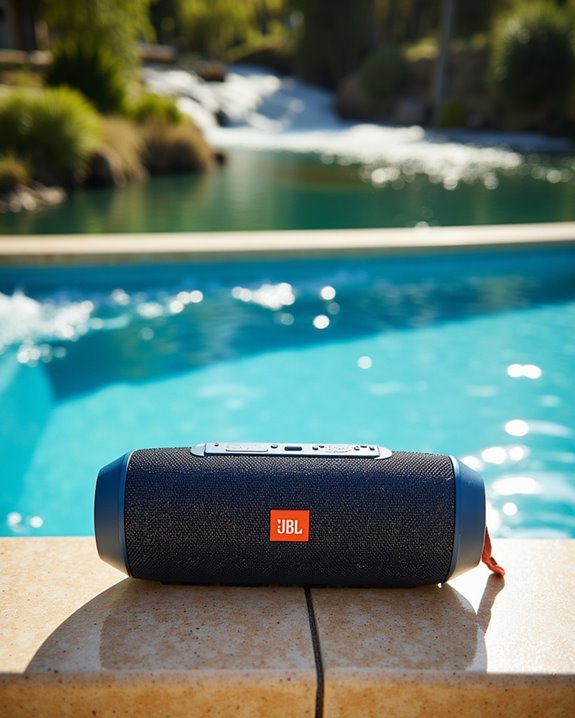
For ideal performance and longevity of JBL waterproof speakers, users must match the device’s IP rating with appropriate water environments. IPX7-rated models remain suitable for river excursions with brief submersion, while IPX8 devices offer superior protection during extended lake activities where continuous water contact occurs.
Beach environments demand IP67-rated speakers due to combined dust and water exposure concerns. After saltwater exposure, immediate freshwater rinsing prevents seal degradation and corrosion. Similarly, chlorinated pool usage requires post-exposure cleaning within one hour to maintain waterproof integrity.
For bathroom installations, IPX7 provides minimal protection against accidental drops, while IPX8 certification guarantees reliable performance in direct shower spray. Regular maintenance, including monthly seal inspection and proper drying after exposure, greatly extends the functional lifespan of waterproof JBL speakers across all aquatic environments.
Frequently Asked Questions
Can I Replace the Rubber Seals on My JBL Speaker Myself?
Seal replacement on JBL speakers is possible but risky. DIY tools like precision screwdrivers and plastic opening tools are needed. Most enthusiasts find professional repair safer to maintain waterproofing integrity and avoid warranty issues.
Are Jbl’s Waterproof Cases Compatible With All Speaker Models?
Dream on, waterproof warriors! JBL’s cases are as universal as a glove that fits one finger. Compatibility testing reveals speaker-specific design limitations, with cases typically fitting only within the same product family—not across all models.
How Does Extreme Cold Affect Waterproof Ratings and Performance?
Extreme cold weather compromises waterproof seals and gaskets, potentially reducing IP67 protection. Freezing temperatures can cause micro-cracks, degrade coatings, and affect battery performance—issues every outdoor enthusiast should consider when bringing speakers on winter adventures.
Will a Waterproof JBL Speaker Float if Dropped in Water?
Sinking and submerging, waterproof JBL speakers typically won’t float if dropped in water. Despite popular Buoyancy Myths, these devices lack the necessary buoyancy. Float Testing confirms they’re designed for waterproofing, not floating capabilities.
Does Using a Silicone Skin Affect the Waterproof Integrity?
Silicone skins may compromise waterproof integrity if they interfere with port seals or trap moisture. Regular skin maintenance is essential. Many users exploring silicone alternatives discover that improperly fitted covers could void warranty protection on their devices.

